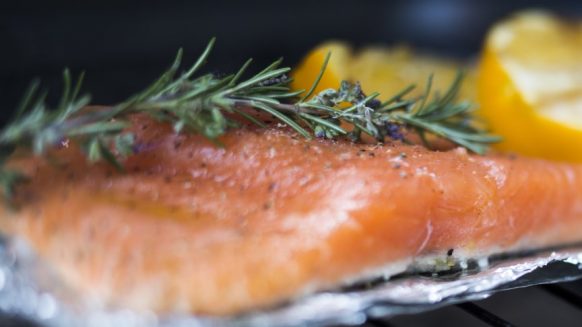Fish
By :
admin |
| On : September 3, 2021 | Category :
Uncategorized
Remember that childhood card game? Used to be fun…not so much anymore, now that we are attempting to prevent or survive cancer. Fish, and everything about it, now seems extremely confusing.
Should we eat it, should we not? What kind should we eat? Does it really need to be wild-caught, or is farmed OK? How should we cook it, on a high temp, or low temp? Marinate it? Is it OK grilled? Should we eat fish with Omega 3’s? Fatty or not? Canned or fresh?
We think we’re doing well when we are out to eat and pass up that char broiled steak on the menu for a piece of blackened salmon, but are we really?
Buying, preparing, cooking, and eating fish can be more than confusing these days. Let’s try to sort through some of the confusion.
Should we eat it?
Let’s start at the beginning with a simple question. Does eating more fish help reduce your chance of getting cancer or a recurrence?
According to the American Cancer Society, some fish are a rich source of omega-3 fatty acids. However studies are still ongoing regarding omega 3’s and the suppression of cancer cells. Studies have shown promise with animals, but more research still needs to be done with humans. Eating fish rich in omega-3 fatty acids is linked with a reduced risk of heart disease and strokes. Omega 3’s have been shown to lower the risk of strokes and heart attacks and help reduce inflammation in the human body.
That being said, we as Americans need to eat more seafood and less red meat. According to The Second Expert Report, published in 2007 by The American Institute for Cancer Research (AICR) and the World Cancer Research Fund (WCRF), there is convincing evidence that processed meats and red meat cause cancer. So fish (and plant-based foods) need to be more prevalent in our diets, whether or not the proof is in yet regarding fish being a cancer-fighting food. We do have evidence that meat is cancer-causing, so fish, regardless of insufficient evidence in studies, is a much better choice.
The American Heart Association and most experts recommend eating fish at least twice a week. Omega-3 fatty acids may help reduce the risk of several diseases, including cancer, and they are found primarily in oily fish that live in cold water.
What kind should we eat?
The fact is, all fish are not created equal. There are actually few fish, according to the Environmental Defense Fund (EDF), that can be consumed healthfully. That is those that are eco-friendly, high in Omega 3’s, and low in mercury content. But does mercury cause cancer? According to the Environmental Protection Agency (EPA), there is no human data that indicates exposure to any form of mercury causes cancer, but the human data that is currently available is very limited. What to do? Putting toxins into our bodies, with limited data available as to their danger, does not make sense. Let’s err on the side of caution and not eat fish that is high in mercury until more data can be uncovered.
Two of the best choices are wild Alaskan salmon and canned salmon. They are high in omega-3’s fat and low in contaminants. (Canned salmon is mostly sockeye or pink from Alaska.)
Other good choices are tuna and Pacific sardines (from the U.S. or Canada), Atlantic mackerel (from Canada), and sablefish, also called black cod (from Alaska or Canada).
Farmed rainbow trout and both farmed and wild shrimp are low in mercury and eco-friendly, but not high in Omega 3’s. Clams and bay scallops are eco-safe and low in mercury. You can find a great chart rating all fish at the edf.org website.

How about canned tuna, which is a staple in almost everyone’s pantry? According to the EPA several species of tuna contain higher-than-average amounts of mercury.
Chunk light and solid white (albacore) are the two main kinds of tuna, and most canned white tuna is albacore. Again, according the EPA, canned white tuna has almost a three times higher mercury level than tuna used in most chunk light canned tuna, so canned light is the safer choice regarding mercury levels.
The following are the EPA’s recommendations for canned tuna:
Canned white, or albacore – Children under six can eat up to one 3-ounce portion a month; children from 6–12, two 4.5-ounce portions a month. Adults, including pregnant women, can safely eat it up to three times a month (women, 6-ounce portions; men, 8-ounce portions).
Canned light- Children under six can eat up to three 3-ounce portions per month. Older children and adults can safely eat it once a week. But look out for “gourmet” or “tonno” labels. They are made with bigger yellowfin tuna and can contain mercury levels comparable to canned white.
How to cook it:
Now that we’ve made our choices and have a healthy fish in our kitchen, what should we do with it? How do we cook it?
According to the ACS, carcinogens can form when cooking both meat and fish. Heterocyclic amines (HCAs) and polycyclic aromatic hydrocarbons (PAHs) are chemicals formed when both meat and fish are cooked using a high-heat, such as pan frying or grilling. So cooking using a high heat should be absolutely avoided. Battered and deep-frying should also be avoided. In the summertime, lighting up the BBQ might be just unavoidable, so here are some grilling tips for healthier grilling:
- Use a less fatty fish.
- Keep a spray bottle with water next to the grill and douse the flare-ups as they happen.
- Don’t place fish directly on the grill, but rather on a piece of foil that has a few holes poked in it.
- Use a marinade. Marinating fish prior to grilling has been shown to greatly reduce the production of HCAs.
- Don’t char or burn the fish.
- Remove the skin from salmon before grilling.
Here are some other hints for healthy fish cooking:
- Microwave the fish first to par-cook it. That way the fish will be exposed less time to a high heat.
- Turn the fish often, rather than leaving it exposed to a heat source for a long period of time.
- If ends of fish should burn, remove charred portions before eating.
- Choose low-fat options, such as olive oil or canola oil spray instead of butter, during the cooking process.
- Use a marinade with antioxidant ingredients such as garlic, rosemary, and oregano. Use cold pressed, extra-virgin olive oil in the marinade.
- Baking, boiling, steaming fish are safer methods of cooking than using a high heat method such as pan or deep frying.
- The less time over a heat, the better. Try baking/poaching the fish in a closed foil or parchment packet.
Avoid smoked fish. Smoked fish contains nitrates and high levels of nitrates may increase your risk of stomach cancer.
All of this might seem a bit confusing and certainly more difficult than just picking up a fried fish sandwich at the drive thru, but once you get in the habit of buying healthy fish and cooking it healthily, it will seem like a snap. It’s worth a little extra effort to “do it right,” because our health is worth it and so are we!
Post Views: 991





